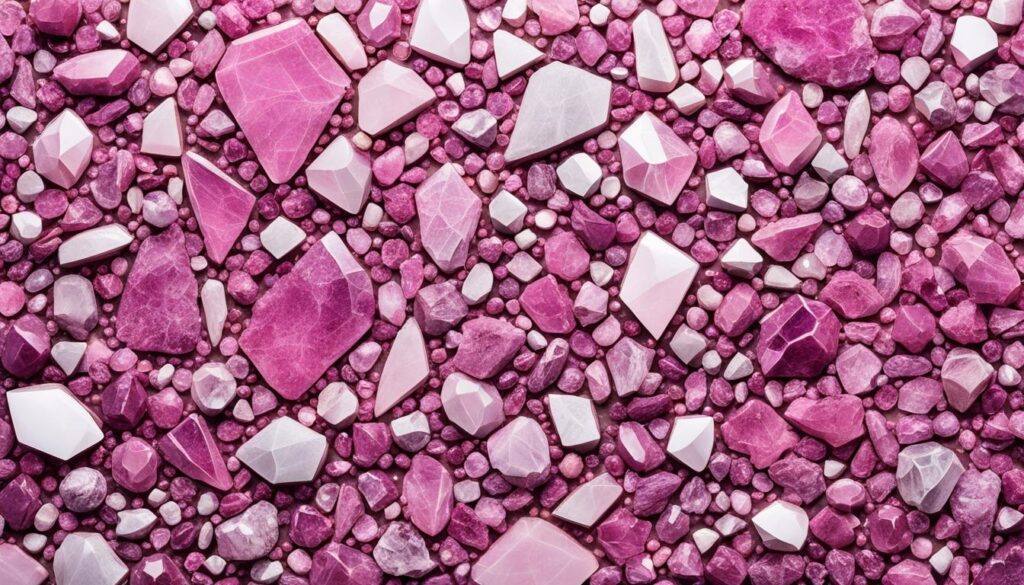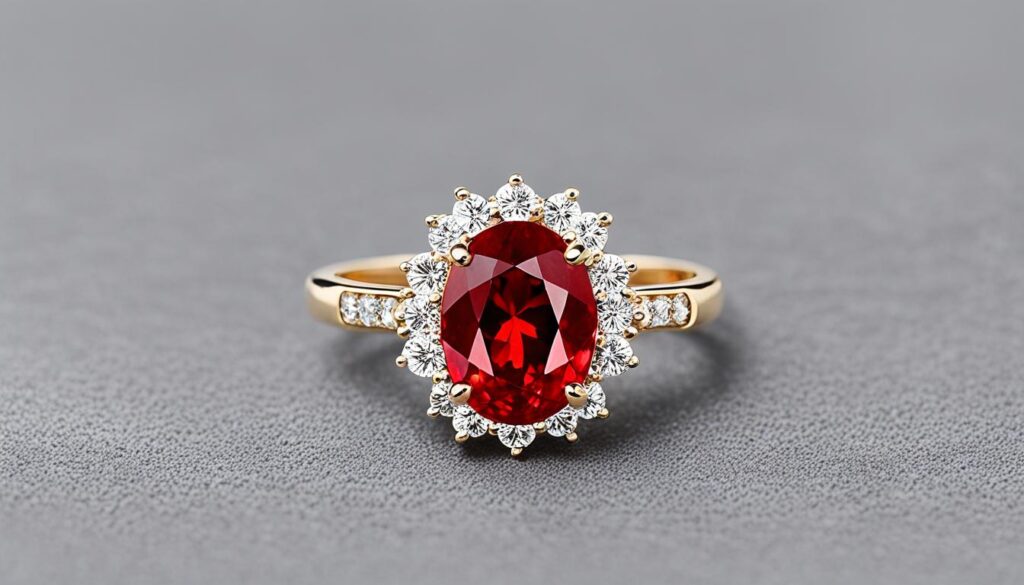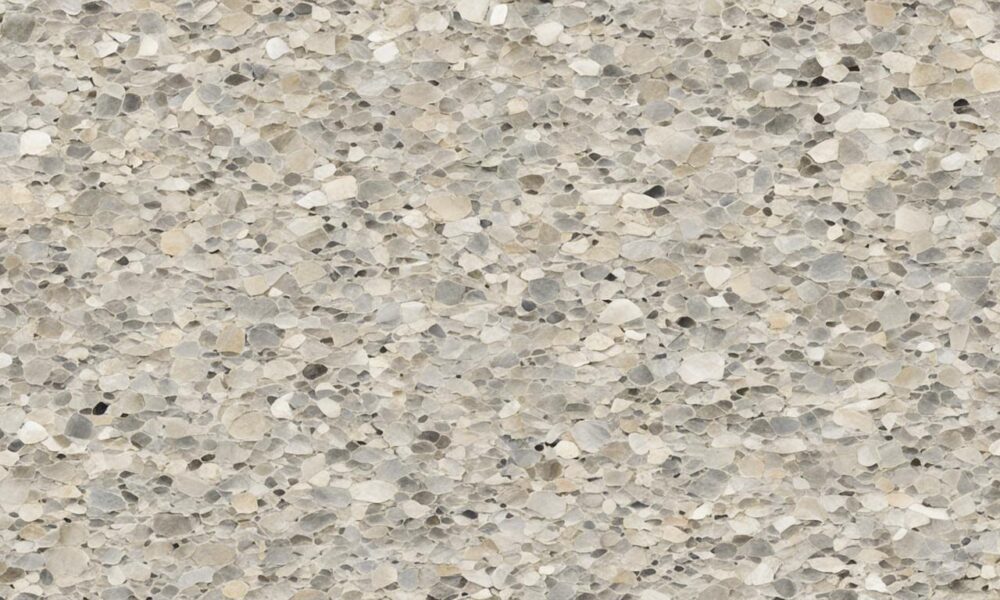Luxury Defined: Most Expensive Natural Stone Revealed
When it comes to luxury stones and high-end materials, rare stone types take center stage in the world of premium stone collections. From their breathtaking beauty to their exclusivity, these natural stones are sought after by those who desire the finest in upscale building materials.
In this article, we will delve into the realm of luxury stones, showcasing some of the most expensive natural stones and exploring their origins, mineralogy, and unique characteristics. Get ready to be captivated by the allure of these exclusive natural stones.
Key Takeaways:
- Gemstones can be classified as the world’s most expensive natural stones based on various factors.
- The rarity and value associated with luxury stones make them highly sought after.
- Each gemstone possesses unique characteristics that contribute to its high-end allure.
- From rare stone types to exclusive natural stones, the world of luxury stones is a treasure trove of beauty.
- Whether used in jewelry or as upscale building materials, these luxury stones redefine opulence.
Jeremejevite – $2,000 per carat
Jeremejevite is an expensive gemstone known for its exquisite beauty and rarity. With a price of $2,000 per carat, it is highly sought after by collectors and enthusiasts. This borate mineral was first discovered in the Adun-Chilon Mountains in Siberia in 1883, adding to its mystique and allure.
What sets Jeremejevite apart is its remarkable gemstone hardness, comparable to quartz. This attribute makes it a durable choice for jewelry-making, ensuring its longevity and value. Its breathtaking appearance, with shades of blue and green, captivates admirers and adds a touch of elegance to any piece.
| Property | Details |
|---|---|
| Price per carat | $2,000 |
| Mineral Composition | Borate mineral |
| Origin | Adun-Chilon Mountains, Siberia |
| Gemstone Hardness | Similar to quartz |
Fire Opal – $2,300 per carat
Fire Opal is an expensive gemstone, priced at $2,300 per carat. It is a mineraloid, which means it lacks a crystal structure. Fire Opal is a hydrated form of silica that can form in different colors depending on environmental conditions during its formation.
One of the most fascinating aspects of Fire Opal is its remarkable opal colors. This gemstone exhibits vibrant hues, including red, orange, and yellow, reminiscent of flames. The colors are a result of the diffraction of light as it passes through the tiny silica spheres present within the stone. This unique interaction creates a mesmerizing play of colors, making Fire Opal truly captivating and sought-after.
“Fire Opal’s vibrant colors give it a captivating allure, making it a popular choice among gemstone enthusiasts looking for a unique and fiery addition to their collection.”
The formation of Fire Opal is influenced by environmental conditions, such as the presence of water and the specific minerals present in the surrounding rocks. These conditions contribute to the opal’s distinctive appearance and make each Fire Opal truly one-of-a-kind.
Due to its vivid colors and the way it seems to illuminate when exposed to light, Fire Opal has gained popularity in the world of jewelry. Its fiery brilliance makes it a perfect gemstone for eye-catching rings, earrings, and pendants.
Fire Opal Facts:
- Fire Opal is a mineraloid, not a mineral, as it lacks a crystal structure.
- It is a hydrated form of silica.
- The gemstone’s colors are the result of the diffraction of light.
- Fire Opal can form in a variety of colors, including red, orange, and yellow.
- The gemstone’s appearance is influenced by environmental conditions during its formation.
Fire Opal Pricing Comparison:
| Gemstone | Price per Carat |
|---|---|
| Fire Opal | $2,300 |
| Comparative Gemstone Prices | |
| Jeremejevite | $2,000 |
| Poudretteite | $3,000 |
| Benitoite | $4,000 |
| Musgravite | $6,000 |
| Red Beryl | $10,000 |
| Alexandrite | $12,000 |
| Diamond | $15,000 |
Poudretteite – $3,000 per carat
Poudretteite is a highly sought-after pink gemstone known for its mesmerizing beauty and exquisite color. With a price of $3,000 per carat, it is considered one of the most valuable gemstones in the world. This rare gem was originally discovered in Mont St. Hilaire Quebec, Canada, and has captivated gem enthusiasts with its unique properties.
The exceptional gem quality of Poudretteite is a testament to its allure. Its captivating pink hue, ranging from delicate pastels to vibrant shades, makes it a sought-after gemstone for collectors and jewelry enthusiasts alike. Its brilliance and transparency allow light to pass through, creating a stunning display of color.

Poudretteite has a Mohs hardness of 5, making it somewhat delicate compared to other gemstones. This characteristic enhances its appeal as a rare and precious collectible. Due to its exceptional beauty and scarcity, gem-quality Poudretteite can command premium prices in the market, with collectors and investors valuing its uniqueness.
Mogok, Burma is another significant source of gem-quality Poudretteite. In 2000, a remarkable Poudretteite crystal weighing 9.41 carats was discovered in Mogok, showcasing the gemstone’s remarkable quality and size.
Whether sought after for its unmatched beauty or collected as an investment, Poudretteite continues to captivate gem enthusiasts with its distinct charm and allure.
Gemstone Properties
| Color | Mohs Hardness | Origin |
|---|---|---|
| Pink | 5 | Mont St. Hilaire Quebec, Canada |
| Pink | 5 | Mogok, Burma |
Benitoite – $4,000 per carat
Benitoite is a rare and expensive blue gemstone, priced at $4,000 per carat. It is composed of barium, titanium, and silica and is formed during the late stage cooling of a hydrothermally altered serpentinite. Benitoite is mainly found in San Benito County, California, and is known for its strong fluorescence and bright blue color.
Benitoite’s unique composition of barium, titanium, and silica gives it its striking blue hue, making it highly sought after by gemstone enthusiasts and collectors. The gemstone’s formation during the late stage cooling of a hydrothermally altered serpentinite results in its exceptional clarity and vibrant color.
The San Benito County in California is the primary source of Benitoite, with the gemstone being discovered there in 1907. Its scarcity and limited availability contribute to its high price tag, making it a prized possession for those looking to acquire a rare and valuable gemstone.
One of the standout features of Benitoite is its strong fluorescence when exposed to ultraviolet light. This quality adds to its allure and makes it a captivating gemstone when viewed under special lighting conditions.
Benitoite remains a highly coveted gemstone due to its exceptional beauty, rarity, and unique characteristics. Its striking blue color, combined with its strong fluorescence, makes it a standout choice for jewelry collectors, enthusiasts, and those seeking a distinctive and precious gemstone.
Musgravite – $6,000 per carat
Musgravite is a rare and expensive gemstone, valued at $6,000 per carat. This stunning gemstone was originally discovered in 1967 in the Musgrave Ranges of Australia. It belongs to the taaffeite family and is known for its incredible beauty and scarcity. Musgravite is formed from aluminum oxide with varying proportions of magnesium, iron, and zinc, giving it a unique composition.
The Musgrave Ranges in Australia are renowned for producing some of the world’s most exquisite gemstones, and musgravite is no exception. Its rarity and exceptional quality make it highly sought after among gemstone collectors and enthusiasts.
One of the factors that contribute to the rarity of musgravite is its limited occurrence in nature. It is found in very small quantities, making it challenging to obtain and increasing its overall value. This scarcity, combined with its mesmerizing color variations and exceptional brilliance, makes musgravite a true treasure.
With its rich hues and remarkable visual appeal, musgravite is a coveted gemstone for creating one-of-a-kind jewelry pieces. Whether set in a ring, pendant, or earrings, musgravite’s vibrant and captivating presence adds a touch of exclusivity and luxury to any collection.
“Musgravite is a true testament to nature’s artistry. Its rarity and beauty make it a highly prized gemstone, sought after by collectors worldwide.”
Experience the allure of musgravite and indulge in the extraordinary beauty of this rare gemstone. Its exquisite composition, coupled with its scarcity, sets musgravite apart as a truly exceptional and unique gemstone in the world of luxury.
The Magnificent Musgravite – A Rarity Worth Admiring
When it comes to gemstones, few can compare to the splendor and scarcity of musgravite. This rare gemstone, originating from the Musgrave Ranges in Australia, captivates with its mesmerizing beauty and extraordinary composition.
Belonging to the taaffeite family, musgravite consists of aluminum oxide, enriched with varying proportions of magnesium, iron, and zinc. It shares its lineage with another esteemed gemstone, taaffeite, further reinforcing its allure.
What truly sets musgravite apart is its rarity. With limited occurrences in nature, musgravite is an elusive gemstone that commands attention. Its scarcity increases its desirability, making it a gemstone that few are fortunate enough to own.
When it comes to its aesthetic appeal, musgravite does not disappoint. Its vibrant colors, ranging from deep purples to rich greens, evoke a sense of awe and admiration. The interplay of light and color within this gemstone creates a captivating visual display that is truly mesmerizing.
It is worth noting that musgravite’s value extends beyond its visual appeal. As a rare gemstone, it represents a sound investment for collectors and connoisseurs. Its exclusivity ensures that its value will only appreciate over time, making it a coveted addition to any gemstone collection.
For those fortunate enough to own musgravite, it is a testament to their discerning taste and appreciation for the extraordinary. This exceptional gemstone not only represents a unique piece of Earth’s geological history but also a reflection of the owner’s refined elegance.
Red Beryl – $10,000 per carat
Red Beryl, also known as bixbite, is an expensive gemstone priced at $10,000 per carat. It is composed of beryllium, aluminum, and silicate and is found in mineralized rhyolite tuffs in the Thomas Range, Utah. Red Beryl is known for its rarity, especially in larger sizes, and is highly prized by collectors.

Red Beryl, with its stunning red color and exceptional clarity, stands out as one of the most coveted gemstones in the world. Its vibrant hue, ranging from pinkish-red to deep red, creates a captivating visual appeal. The combination of beryllium, aluminum, and silicate in its composition gives Red Beryl its distinctive beauty.
What sets Red Beryl apart from other gemstones is its scarcity. The Thomas Range in Utah is the primary source of this precious gem. However, even within this region, Red Beryl is found in only a few locations, making it a true rarity. It is estimated that less than one faceted Red Beryl gemstone is produced for every 150,000 gem-quality diamonds.
In addition to its rarity, Red Beryl is known for its typically small sizes. The gemstones are often found in sizes ranging from a few millimeters to less than one carat. Larger Red Beryl gemstones are exceptionally rare, making them highly sought after by collectors and enthusiasts.
When cut and faceted, Red Beryl exhibits exceptional brilliance and fire. Its rich red color, combined with its high refractive index, makes it a captivating gemstone that commands attention. This unique combination of rarity, small sizes, and exceptional beauty contributes to the high value of Red Beryl in the gemstone market.
Alexandrite – $12,000 per carat
Alexandrite is an expensive gemstone that fetches a price of $12,000 per carat. It belongs to the chrysoberyl family and was first discovered in the Ural Mountains of Russia in the 1830s.
Alexandrite is renowned for its exceptional color-changing properties. In natural light, it appears green, while in incandescent or artificial light, it transforms into a captivating ruby red. This unique phenomenon is caused by the presence of chromium impurities within the crystal structure.
The size of the alexandrite gemstone also plays a significant role in its price. Larger alexandrites are rarer and command higher premiums, making them highly sought after by collectors and connoisseurs.
With its mesmerizing color-changing effects and association with the historic Ural Mountains, alexandrite remains a prized gemstone for those who appreciate its beauty and rarity.
| Price | Color | Origin | Properties |
|---|---|---|---|
| $12,000 per carat | Green to ruby red | Ural Mountains, Russia | Color-changing properties due to chromium impurities |
Diamond – $15,000 per carat
Diamonds are the epitome of luxury and elegance. Composed of pure carbon arranged in a diamond lattice, diamonds possess unparalleled hardness and durability, making them one of the hardest materials on Earth. With a price of $15,000 per carat, diamonds are highly sought after for their exceptional beauty and rarity.
These exquisite gemstones are formed deep within the Earth’s mantle, under intense heat and pressure, over billions of years. They are brought to the surface through volcanic eruptions and can be found in cooled kimberlites, a type of volcanic rock.
Diamonds have been treasured for centuries and are especially popular as the centerpiece of engagement rings, representing love, commitment, and endurance. Their timeless appeal and ability to withstand the test of time make them a symbol of lasting relationships.
Diamond Characteristics
Diamonds are valued for their unique characteristics, known as the four Cs: color, clarity, cut, and carat weight. The color of a diamond can range from colorless to fancy colors, with colorless diamonds being the most valuable. Clarity refers to the presence of internal or external flaws, with flawless diamonds being extremely rare and highly prized. The cut of a diamond determines its brilliance and sparkle, with well-cut diamonds reflecting light in a captivating manner. Carat weight, on the other hand, pertains to the size or weight of the diamond, with larger diamonds generally being more valuable.
The value of diamonds also lies in their ability to retain their worth over time. While market fluctuations can affect the price of diamonds, diamonds have a long history of possessing value-retention properties. This makes them a sound investment and a timeless treasure to pass down through generations.
Famous Diamonds
Diamonds have captured the imagination of people around the world and have become associated with legendary stories and iconic figures. Some of the most famous diamonds include:
- The Hope Diamond: A stunning blue diamond with a mysterious history, known for its deep blue color and exceptional size, weighing 45.52 carats.
- The Koh-i-Noor Diamond: Considered one of the largest diamonds in the world, this diamond has a rich history and is part of the British Crown Jewels.
- The Cullinan Diamond: This diamond holds the title of the largest gem-quality rough diamond ever discovered, weighing a staggering 3,106.75 carats. It has been cut into several smaller diamonds, many of which are part of royal collections.
These famous diamonds showcase the enduring allure and value of diamonds, further cementing their status as the pinnacle of luxury and prestige.
| Characteristics | Value |
|---|---|
| Hardness | Extreme |
| Durability | Excellent |
| Brilliance | Exceptional |
| Value Retention | High |
Conclusion
In conclusion, the world of luxury stones and expensive gemstones offers a fascinating glimpse into the realm of rare and valuable treasures. Each gemstone, from Jeremejevite to Diamonds, possesses its own unique characteristics that contribute to its high value. These gemstones are classified based on factors such as their chemical composition, mineralogy, and rarity, making them highly sought after by collectors and enthusiasts alike.
With prices ranging from $2,000 to over $1 million per carat, these gemstones represent the epitome of luxury and exclusivity. Whether used in jewelry or as decorative pieces, they are a testament to exquisite craftsmanship and timeless beauty. The allure of these high-end materials lies not only in their rarity and gemstone value but also in the unique characteristics that set them apart.
From the captivating allure of the blue Benitoite to the mesmerizing color-changing properties of Alexandrite, these gemstones captivate the imagination and evoke a sense of wonder. They are more than just stones; they are symbols of elegance, sophistication, and discerning taste. Whether adorning the wrists, fingers, or necks of the world’s elite or gracing the halls of prestigious institutions, luxury stones leave an indelible mark on those fortunate enough to possess them.



